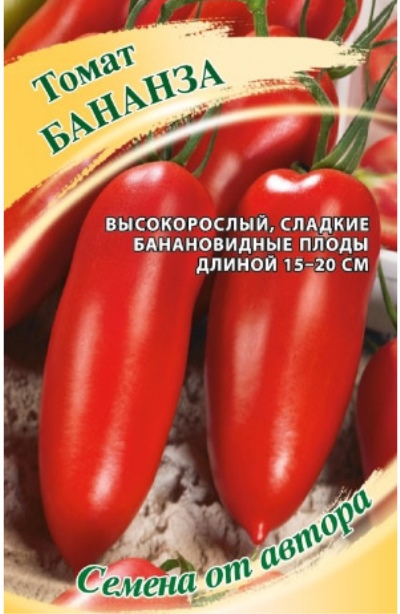
- Authors: Gavrish S.F., Morev V.V., Amcheslavskaya E.V., Degovtsova T.V., Volok O.A. (LLC "Gavrish Breeding Firm")
- Year of approval: 2015
- Category: grade
- Growth type: indeterminate
- Appointment: fresh consumption, for whole-fruit preservation, for ketchup and tomato paste
- Ripening period: mid-season
- Ripening time, days: 100-110
- Growing conditions: for film greenhouses, for greenhouses
- Bush size: tall
- Bush height, cm: 150-200
One of the wonderful mid-season varieties, whose beautiful fruits are great in whole-fruit canning, sauces and pastes, ideal for drying - the universal indeterminate Bananza tomato. It is used for cultivation in greenhouses and is available for cultivation by gardeners in all regions.
Breeding history
The authors of the Bananza variety were the breeders of LLC "Gavrish Breeding Company" S. S. Gavrish, V. V. Morevu, E. V. Amcheslavskaya, T. V. Degovtsova, O. A. Volok. The year of approval for cultivation is 2015.
Description of the variety
Bananza is bred as an indeterminate high-yielding variety with unlimited growth, which makes bush formation and pinching activities mandatory. Well-leafed tall bushes (150-200 cm) covered with medium-sized light green foliage. Yellow male and female flowers are collected in intermediate inflorescences and form an ovary up to 12-15 pieces each. In a branched uviform cluster, the fruits are attached to strong, articulated peduncles. The average hand weight reaches 2 kg, so sometimes they need an individual garter.
The main qualities of the fruit
Fruits weighing 120-140 g, long (15-20 cm) cylindrical, slightly ribbed banana-shaped fruits are covered with a very dense skin that protects tomatoes from cracking during heat treatment and in the garden under adverse weather conditions. The same indicator provides good transportability and long-term storage. Unripe green fruits turn carmine red at the stage of ripeness. Bananza has a small number of seed chambers and seeds.
Taste characteristics
The pulp of a pleasant consistency has a bright tomato flavor, increased sugar content and moderate acidity. A large amount of dry matter - up to 7% allows you to dry juicy fruits.
Ripening and fruiting
Mid-season culture - from 100 to 110 days from the time of sowing. The official harvest dates are July and August, but it should be borne in mind that the fruits are harvested at different stages of ripeness. Fully ripe red tomatoes are suitable for salads, cooking ketchups, tomato pastes. The brown stage is selected for whole-fruit conservation.
Yield
Bananza belongs to high-yielding varieties - up to 5 kilograms and 8-10 kilograms per square meter can be harvested from a bush.
The timing of planting seedlings and planting in the ground
Sowing for seedlings, with preliminary seed treatment, is carried out at the end of February, at the beginning of March. Grown up and matured seedlings are planted in greenhouses in late April - early May. At the same time, the final dates are determined individually in each specific region - in the northern regions this is done later.

Growing tomato seedlings is an extremely important process, because it largely depends on whether the gardener can harvest at all. All aspects must be taken into account, from seedbed preparation to planting in the ground.
Landing scheme
When planting, observe the 40x60 cm pattern between the roots.

Growing and care
The soil in the greenhouse must be breathable, rich in humus and minerals. In autumn, organic matter (humus, compost, bird droppings in limited quantities) is introduced for digging, in the spring prepared ridges are filled with complex mineral fertilizers, wood ash is added, and supports are installed for each root. At a certain time, the grown seedlings are transplanted into prepared holes, the soil is compacted and shed well.
Loosening is mandatory after each watering; you can replace it with mulching. The cultivation of this variety requires the formation of a bush in one trunk, regulation of growth, constant pinching and tying. After the plant has formed the first brush, the lower leaves are cut off, providing high-quality ventilation. Further care consists in watering, as well as weeding and feeding. The plant needs nitrogen composition during the period of growing vegetative mass, in potassium-phosphorus preparations during budding and filling. In addition to ready-made fertilizers, an aged solution of a fresh mullein, fermented infusions of nettle with the addition of grain residues are very effective.




A plant needs different micronutrients at each stage of growth. All fertilizers can be divided into two groups: mineral and organic. Folk remedies are often used: iodine, yeast, bird droppings, eggshells.
It is important to observe the rate and period of feeding. This also applies to folk remedies and organic fertilizers.
Disease and pest resistance
The plant has good resistance to many diseases, but greenhouse conditions and high humidity can lead to late blight and other diseases. In order to avoid damage to plantings by fungal diseases and pests, prevention is necessary.


Resistant to adverse weather conditions
A heat-loving plant does not tolerate rainy weather, prolonged temperature drop. There is a suppression of vitality, tomatoes stop development, become weak, the risk of developing diseases increases, and outbreaks of late blight are observed.
Growing regions
A versatile and unpretentious tomato is grown everywhere, these are the North, North-West, Central, Volgo-Vyatka, Central Black Earth Region, North Caucasian, Middle Volga, Lower Volga, Ural, West Siberian, East Siberian, Far Eastern regions.

























































































